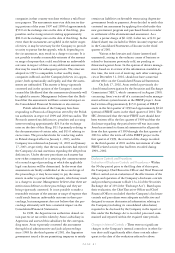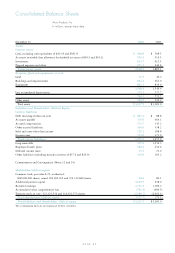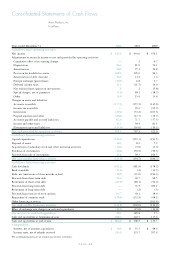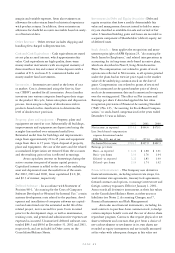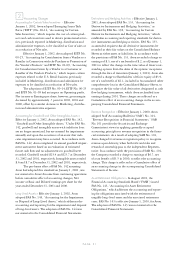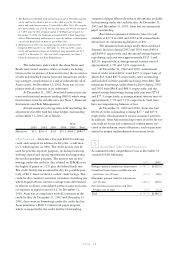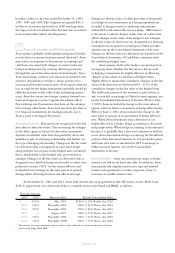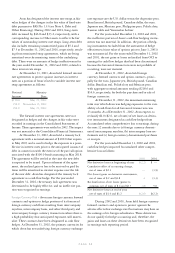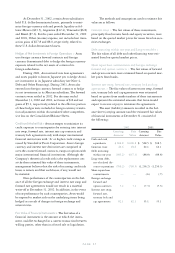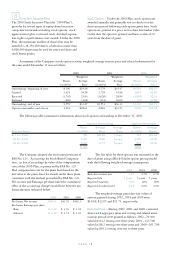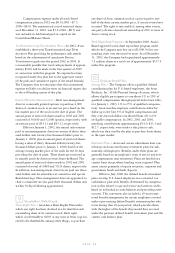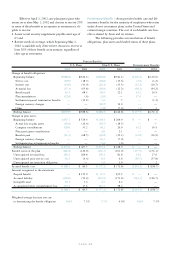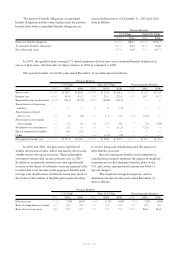Avon 2001 Annual Report Download - page 27
Download and view the complete annual report
Please find page 27 of the 2001 Avon annual report below. You can navigate through the pages in the report by either clicking on the pages listed below, or by using the keyword search tool below to find specific information within the annual report.
PAGE 51
Accounting Changes
Accounting for Certain Sales Incentives >Effective
January 1, 2002, Avon adopted Emerging Issues Task
Force (“EITF”) No. 00-14, “Accounting for Certain
Sales Incentives,” which requires the cost of certain prod-
ucts and cash incentives used in Avon’s promotional activi-
ties, previously reported in Marketing, distribution and
administrative expenses, to be classified as Cost of sales or
as a reduction of Net sales.
Effective January 1, 2002, Avon adopted EITF No.
00-25, “Accounting for Consideration from a Vendor to a
Retailer in Connection with the Purchase or Promotion of
the Vendor’s Products” and EITF No. 01-09, “Accounting
for Consideration Given by a Vendor to a Customer or
Reseller of the Vendor’s Products,” which require certain
expenses related to the U.S. Retail business previously
included in Marketing, distribution and administrative
expenses to be classified as a reduction of Net sales.
The adoptions of EITF No. 00-14, EITF No. 00-25
and EITF No. 01-09 had no impact on Operating profit,
Net income or Earnings per share; however, gross margin
decreased by approximately .7 point in 2002, 2001 and
2000, offset by a similar decrease in Marketing, distribu-
tion and administrative expenses.
Accounting for Goodwill and Other Intangibles Assets >
Effective January 1, 2002, Avon adopted FAS No. 142,
“Goodwill and Other Intangible Assets.” Under FAS No.
142, goodwill and intangible assets with indefinite lives
are no longer amortized, but are assessed for impairment
annually and upon the occurrence of an event that indi-
cates impairment may have occurred. In accordance with
FAS No. 142, Avon completed its annual goodwill impair-
ment assessment based on an evaluation of estimated
future cash flow and no adjustments to goodwill were
recorded. Goodwill totaled $25.4 and $23.7 at December
31, 2002 and 2001, respectively. Intangible assets totaled
$.6 and $.7 at December 31, 2002 and 2001, respectively.
The pro-forma effect of FAS No. 142 assuming
Avon had adopted this standard on January 1, 2001, was
not material to Avon’s Income from continuing operations
before cumulative effect of accounting changes, Net
income or Basic and Diluted earnings per share for the
years ended December 31, 2001 and 2000.
Long-Lived Assets > Effective January 1, 2002, Avon
adopted FAS No. 144, “Accounting for the Impairment
or Disposal of Long-Lived Assets,” which addresses the
accounting and reporting for the impairment and disposal
of long-lived assets. The adoption of FAS No. 144 was
not material to the Consolidated Financial Statements.
2Derivatives and Hedging Activities > Effective January 1,
2001, Avon adopted FAS No. 133, “Accounting for
Derivative Instruments and Hedging Activities,” as
amended by FAS No. 138, “Accounting for Certain
Derivative Instruments and Hedging Activities,” which
establishes accounting and reporting standards for deriva-
tive instruments and hedging activities. FAS No. 133,
as amended, requires that all derivative instruments be
recorded at their fair values on the Consolidated Balance
Sheets as either assets or liabilities. In accordance with
the provisions of FAS No. 133, Avon recorded a charge to
earnings of $.3, net of a tax benefit of $.2, as of January 1,
2001 to reflect the change in the time value of Avon’s out-
standing options from the dates of the options’ inceptions
through the date of transition (January 1, 2001). Avon also
recorded a charge to Shareholders’ (deficit) equity of $3.9,
net of a tax benefit of $2.1, included in Accumulated other
comprehensive loss in the Consolidated Balance Sheets, to
recognize the fair value of all derivatives designated as cash
flow hedging instruments, which Avon reclassified into
earnings during 2001. These charges are reflected as a
Cumulative effect of an accounting change in the accom-
panying Consolidated Financial Statements.
Revenue Recognition > Effective January 1, 2000, Avon
adopted Staff Accounting Bulletin (“SAB”) No. 101,
“Revenue Recognition in Financial Statements.” SAB
No. 101 provides the Securities and Exchange
Commission’s views in applying generally accepted
accounting principles to revenue recognition in the finan-
cial statements. As a result of adopting SAB No. 101,
Avon changed its revenue recognition policy to recognize
revenue upon delivery, when both title and risks and
rewards of ownership pass to the independent Represen-
tative. In accordance with the provisions of SAB No. 101,
the Company recorded a charge to earnings of $6.7, net
of a tax benefit of $3.5 in 2000, to reflect the accounting
change. This charge is reflected as a Cumulative effect of
an accounting change in the accompanying Consolidated
Statements of Income.
Asset Retirement Obligations > In August 2001, the
Financial Accounting Standards Board (“FASB”) issued
FAS No. 143, “Accounting for Asset Retirement
Obligations,” which addresses the accounting and report-
ing for obligations associated with the retirement of
tangible long-lived assets and the associated retirement
costs. FAS No. 143 is effective January 1, 2003, for Avon.
The adoption of FAS No. 143 was not material to the
Consolidated Financial Statements.


